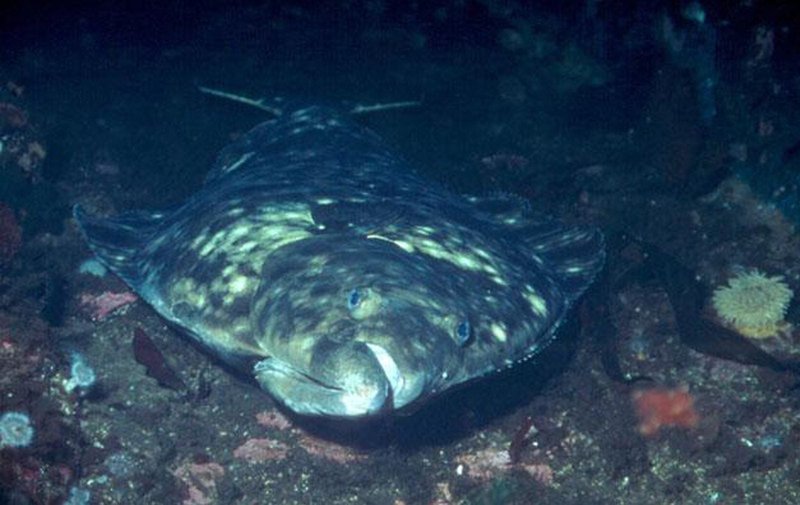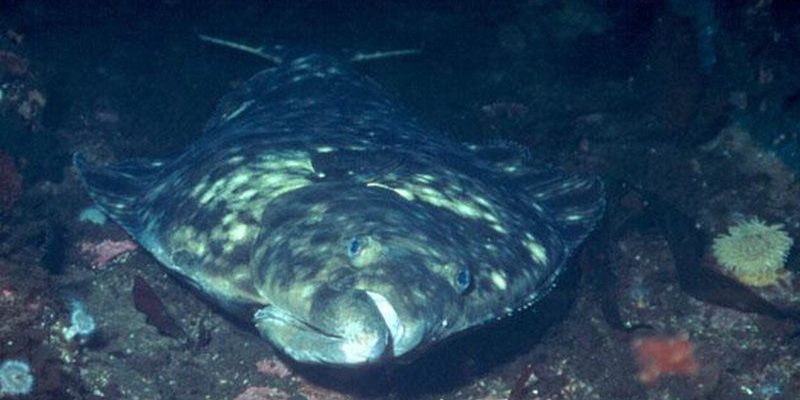
When you think of halibut, imagine a large, flat fish gliding gracefully through the chilly waters of the North Atlantic and North Pacific. These fish are not your typical swimmers; they possess a unique shape and a fascinating life cycle that makes them stand out in the vast ocean. With their delicious taste and impressive size, halibut has become a favorite among seafood lovers and fishermen alike.
Halibut are flatfish, which means they have both eyes on one side of their body. This eccentricity allows them to blend seamlessly into the ocean floor, an efficient strategy for both hunting prey and avoiding predators. The name “halibut” comes from Old English, meaning “holy flatfish,” since they were commonly eaten on feast days. Today, let’s dive deeper into the world of halibut, exploring their habitat, diet, and much more.
What is Halibut?
Halibut belong to the family of flatfish known as Pleuronectidae, which includes species like the Pacific halibut and the Atlantic halibut. These fish are known for their distinctive flat shape and large size, with some individuals weighing over 500 pounds! Halibut have a soft, white flesh that is highly regarded for its mild flavor and firm texture, making it a popular choice for various culinary dishes.
One of the most intriguing aspects of halibut is their unique life cycle. Like many fish, they start as larvae that swim freely in the ocean. As they grow, they undergo a fascinating transformation, where one side of their body flattens while the other develops the characteristic features we associate with halibut. This transformation is not only remarkable but essential for their survival in the wild.
Characteristics of Halibut
| Scientific Name: | Hippoglossus |
| Habitat: | Cold waters of the North Atlantic and North Pacific |
| Diet: | Fish, crustaceans, and other marine organisms |
| Size: | Up to 500 pounds and 8 feet long |
| Lifespan: | Up to 25 years |
Habitat of Halibut
Halibut thrive in cold, deep waters, typically found at depths ranging from 20 to 1,200 feet. They prefer sandy or muddy bottoms, where they can easily camouflage themselves against predators and surprise their prey. These fish can be found in both the Atlantic and Pacific Oceans, with Pacific halibut predominantly located along the coasts of Alaska and Canada, while Atlantic halibut are found primarily around Greenland, Iceland, and the northeastern coast of the United States.
The temperature of their habitat is also crucial for their survival. Halibut prefer waters between 30°F and 60°F, which is relatively cold compared to many other fish species. This adaptability to cold environments allows them to thrive where other fish might struggle, providing them a competitive advantage when hunting for food.
Diet and Feeding Habits
Halibut are opportunistic feeders, which means they will eat whatever is readily available. Their diet primarily consists of smaller fish such as herring, sand lance, and even smaller flatfish. They also consume crustaceans, squid, and any marine organisms that come within reach. This varied diet helps maintain their large size and powerful physique.
When hunting, halibut utilize their camouflage to lie still on the ocean floor, waiting for unsuspecting prey to swim by. Once they spot a potential meal, they strike with lightning speed. Their flat, wide mouths are perfectly designed for engulfing larger prey in a single swift motion. This hunting technique not only showcases their strength but also their strategic approach to feeding in a competitive ocean environment.
Reproduction and Life Cycle
Halibut reproduce through a process known as external fertilization, which means that females release their eggs into the water while males simultaneously release sperm. This usually occurs in deeper waters during the spring months. The fertilized eggs drift with ocean currents before hatching into larvae, which float near the surface in the plankton layer.
As these larvae grow, they begin their transformative journey. Initially, they swim upright, but as they develop, one side flattens, and they begin to swim on their sides. Eventually, they lose the ability to swim vertically and become fully adapted to life on the ocean floor as juvenile halibut. This transformation is critical for survival, as they need to blend in with their surroundings to evade predators.
Conservation Status of Halibut
The conservation status of halibut varies by species and location. The Pacific halibut, for example, has a well-managed fishery and is considered to be at a healthy population level due to strict regulations and sustainable fishing practices. However, Atlantic halibut populations have faced significant declines over the years, leading to stricter regulations to encourage recovery.
Conservation efforts are essential to ensure the longevity of halibut species. Responsible fishing practices and marine protected areas help to maintain their populations. As consumers, we can also play a role by choosing sustainably sourced seafood, which supports healthier oceans and the ecosystems that rely on them.
Cooking and Enjoying Halibut
Cooking halibut is a delightful experience thanks to its mild flavor and texture. Whether grilled, baked, or pan-seared, halibut can be prepared in countless ways to suit various tastes. Its meaty flesh holds up beautifully in different recipes, making it a favorite for both home cooks and professional chefs.
One popular preparation method is baking halibut with a light seasoning of lemon, garlic, and herbs. This method enhances the natural flavors while remaining simple and healthy. You might also enjoy grilling halibut steaks, which give the fish a delicious smoky flavor that perfectly complements summer evenings.
Fun Facts About Halibut
- Halibut can change color to blend in with their surroundings, aiding in their camouflage.
- These fish are among the largest flatfish in the world.
- Halibut have a unique ability to detect vibrations in the water, which helps them locate prey.
- They can live up to 25 years in the wild!
FAQ
How do you identify a halibut?
Identifying a halibut is relatively easy if you know what to look for. These fish have a distinct flattened body shape with both eyes located on one side. The top side is often a dark brown or greenish color, while the underside is white. Adult halibut can grow quite large, reaching lengths of up to 8 feet and weights of over 500 pounds! They also have a prominent dorsal fin that runs along their back.
Are halibut and flounder the same?
No, while both halibut and flounder are flatfish, they belong to different families and have distinct characteristics. Halibut are much larger compared to most flounder species. Additionally, halibut have a more elongated body shape, while flounders tend to be rounder. The culinary uses may also differ, with halibut often preferred for its firmer texture.
What is the best way to cook halibut?
The best way to cook halibut depends on personal preference, but some of the most popular methods include baking, grilling, and pan-searing. Baking is a fantastic option for preserving moisture, while grilling can impart a delightful smoky flavor. When cooking halibut, aim for an internal temperature of 145°F to ensure it’s thoroughly cooked yet still moist and tender.
Is halibut sustainable to eat?
Sustainability varies between species and fishing practices. Pacific halibut is generally considered sustainable due to effective management and regulations. However, Atlantic halibut populations have declined and are currently less sustainable. To make informed choices, look for seafood certifications like the Marine Stewardship Council (MSC) label, which indicates sustainable sourcing.
How can I tell if halibut is fresh?
Fresh halibut should smell clean and mild, not fishy or sour. The flesh should be firm to the touch and should spring back when pressed. Look for a translucent appearance and a bright, white color on the flesh. If buying whole fish, clear eyes and shiny scales are good indicators of freshness.
Can halibut be frozen?
Yes, halibut can be frozen! For the best quality, wrap it tightly in plastic wrap and then place it in a freezer bag to prevent freezer burn. When stored properly, halibut can maintain its quality for up to six months in the freezer. To use, simply thaw it in the refrigerator overnight before cooking.
What do halibut larvae look like?
Halibut larvae are tiny and quite different from adult halibut. They are initially round and have small fins. As they grow, they begin to flatten, and one eye migrates to the other side of their body. This change is crucial for their survival, as it prepares them for life as bottom-dwelling fish in the ocean.
Are halibut caught commercially?
Yes, halibut are a major target for commercial fishing, especially Pacific halibut. Fishermen use various methods to catch them, including longlines and traps. The fishery is well-regulated to ensure sustainable practices, allowing fishing communities to thrive while protecting halibut populations.
How does halibut compare to other white fish?
Halibut stands out among other white fish due to its meaty texture and mild flavor. Compared to cod or tilapia, halibut has a firmer flesh that holds up well during cooking. While all these fish are great sources of protein and excellent for various dishes, halibut is often considered a premium choice due to its size and unique flavor profile.
Can halibut live in freshwater?
No, halibut are marine fish and cannot survive in freshwater environments. They thrive solely in saltwater, specifically in the cold waters of the North Atlantic and North Pacific oceans. Their biology is adapted for life in these salty conditions, making freshwater unsuitable for their needs.

